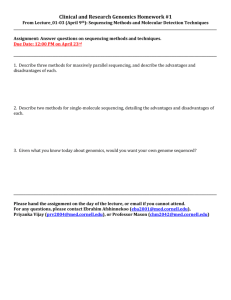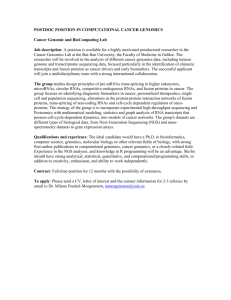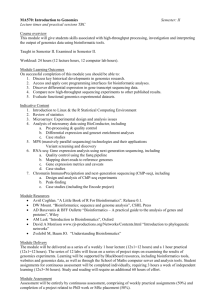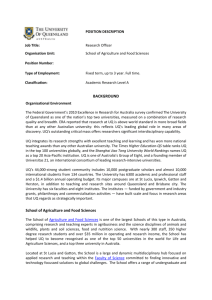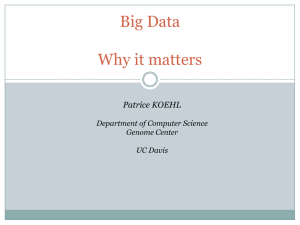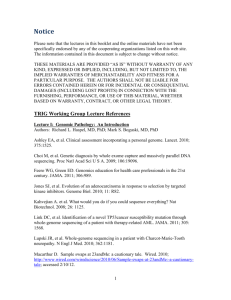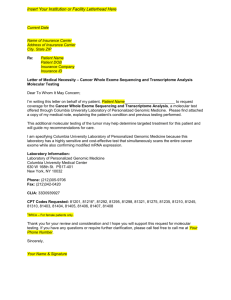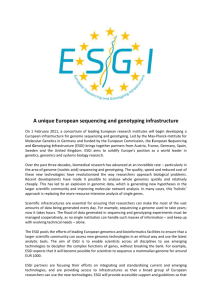Syllabus
advertisement
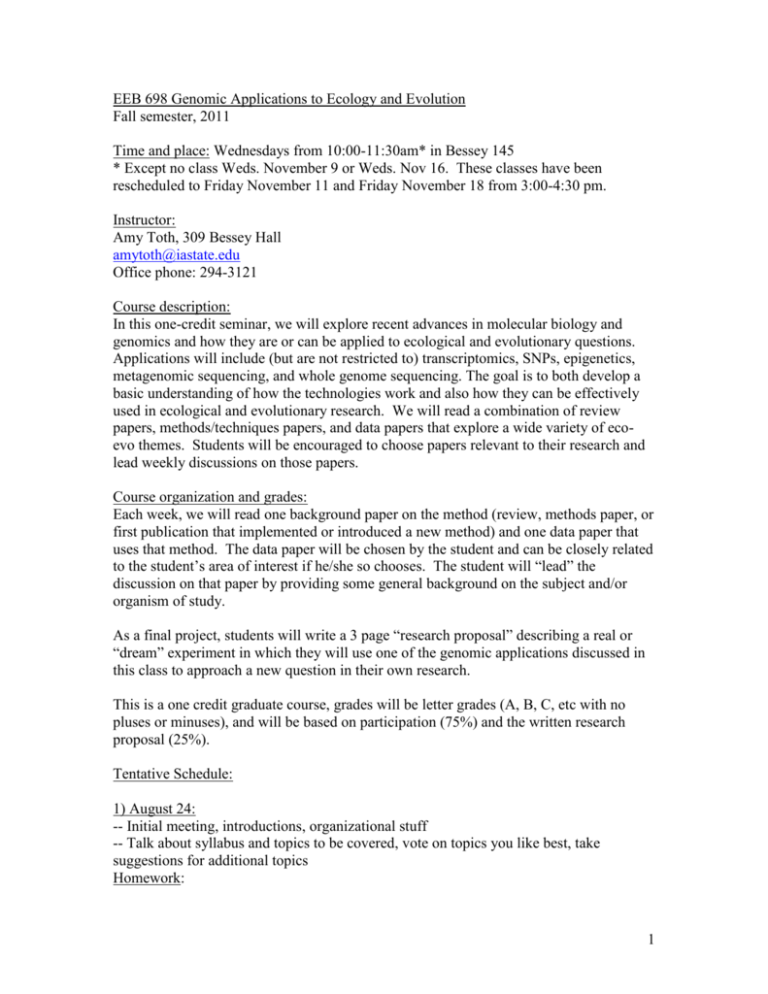
EEB 698 Genomic Applications to Ecology and Evolution Fall semester, 2011 Time and place: Wednesdays from 10:00-11:30am* in Bessey 145 * Except no class Weds. November 9 or Weds. Nov 16. These classes have been rescheduled to Friday November 11 and Friday November 18 from 3:00-4:30 pm. Instructor: Amy Toth, 309 Bessey Hall amytoth@iastate.edu Office phone: 294-3121 Course description: In this one-credit seminar, we will explore recent advances in molecular biology and genomics and how they are or can be applied to ecological and evolutionary questions. Applications will include (but are not restricted to) transcriptomics, SNPs, epigenetics, metagenomic sequencing, and whole genome sequencing. The goal is to both develop a basic understanding of how the technologies work and also how they can be effectively used in ecological and evolutionary research. We will read a combination of review papers, methods/techniques papers, and data papers that explore a wide variety of ecoevo themes. Students will be encouraged to choose papers relevant to their research and lead weekly discussions on those papers. Course organization and grades: Each week, we will read one background paper on the method (review, methods paper, or first publication that implemented or introduced a new method) and one data paper that uses that method. The data paper will be chosen by the student and can be closely related to the student’s area of interest if he/she so chooses. The student will “lead” the discussion on that paper by providing some general background on the subject and/or organism of study. As a final project, students will write a 3 page “research proposal” describing a real or “dream” experiment in which they will use one of the genomic applications discussed in this class to approach a new question in their own research. This is a one credit graduate course, grades will be letter grades (A, B, C, etc with no pluses or minuses), and will be based on participation (75%) and the written research proposal (25%). Tentative Schedule: 1) August 24: -- Initial meeting, introductions, organizational stuff -- Talk about syllabus and topics to be covered, vote on topics you like best, take suggestions for additional topics Homework: 1 -- Come next week with abstracts from 3 to 4 data papers you are interested in, using at least two different genomic methods, that you would consider leading a discussion on. Turn in printouts of the abstracts with the genomic method highlighted or noted on the abstract. -- Read Rokas and Abbot 2009 and Ekblom and Galindo 2011 2) August 31: Introduction to eco-evo genomics, discuss papers, turn in your abstracts Reviews: Antonis Rokas and Patrick Abbot. 2009. Harnessing genomics for evolutionary insights, Trends in Ecology & Evolution 24: 192-200. R. Ekblom and J. Galindo. 2011. Applications of next generation sequencing in molecular ecology of non-model organisms. Heredity 107, 1–15. Homework: -- For next class, be prepared to choose from 2-3 topics and data papers that interest you, as we will set up a schedule for the semester -- Read Mardis 2008, table from Metzker 2010, handouts on Helicos, PacBio, and Ion torrent. 3) September 7: Overview of next generation sequencing methods, set up schedule for semester Reviews: Mardis, E.R. 2008. Next-Generation DNA Sequencing Methods. Annu. Rev. Genomics Hum. Genet. 9:387–40. Metzker, M.L. 2010. Sequencing technologies—the next generation. Nature Reviews Genetics 11:31-46. (Whole paper is not assigned, but please look at Table 1 and this paper can be used as a reference) Short news pieces on Helicos, Pacific Biosystems, and Ion Torrent sequencing. Homework: Read Chain et al. 2009, Imelfort and Edwards 2009, and Li et al. 2010. 4) September 14: Genome projects: De novo whole genome sequencing using nextgen platforms (Amy Toth) Reviews: P. S. G. Chain, et al. 2009. Genome Project Standards in a New Era of Sequencing. Science 326: 236-237. Imelfort, M. and Edwards. D. 2009. De novo sequencing of plant genomes using secondgeneration technologies. Briefings in Bioinformatics 10: 609-618. Data paper: Ruiqiang, Li et al. 2010. The sequence and de novo assembly of the giant panda genome. Nature 463: 311-317. Homework: Read Wheat et al. 2010 and Schwartz et al. 2010. 5) September 21: Characterizing a transcriptome: de novo transcriptome sequencing (Tonia Schwartz) Review: 2 Wheat, C.W. 2010. Rapidly developing functional genomics in ecological model systems via 454 transcriptome sequencing. Genetica 138:433–451. Data paper: Schwartz et al. 2010. A garter snake transcriptome: pyrosequencing, de novo assembly, and sex-specific differences. BMC Genomics 11:694. 6) September 28: Measuring gene expression 2: quantitative RNA-sequencing (Antonio Cordero) Review: Zhong Wang, Mark Gerstein & Michael Snyder. 2009. RNA-Seq: a revolutionary tool for transcriptomics. Nature Reviews Genetics 10, 57-63. Data paper: Guo, H. et al. 2010. Mammalian microRNAs predominantly act to decrease target mRNA levels. Nature 466: 835-840. 7) October 5: Metagenomic sequencing of microbial diversity (Sarah Hargreaves) Review: Carola Simon and Rolf Daniel. 2011. Metagenomic Analyses: Past and Future Trends. Applied and Environmental Microbiology 77: 1153–1161. Data paper: Mendes, R., M. Kruijt, I. de Bruijn, E. Dekkers, M. van der Voort, J. H. M. Schneider, Y. M. Piceno, T. Z. DeSantis, G. L. Andersen, P. A. H. M. Bakker, and J. M. Raaijmakers. 2011a. Deciphering the Rhizosphere Microbiome for DiseaseSuppressive Bacteria. Science 332:1097–1100. doi: 10.1126/science.1203980. 8) October 12: Population genomics and genetic markers (Arun Sethuraman) Reviews: Stinchcombe, J.R. and Hoekstra, H.E. 2008. Combining population genomics and quantitative genetics: finding genes underlying ecologically important traits. Heredity 100: 158-170. Davey, J.W. et al. 2011. Genome-wide genetic marker discovery and genotyping using next-generation sequencing. Nature Reviews Genetics 12: 499-510. Data paper: Hohenlohe, P.A. et al. 2010. Population genomics of parallel adaptation in threespine stickleback using sequenced RAD tags. PLoS Genetics 6: e1000862. 9) October 19: Single nucleotide polymorphisms (Jeanine Refsnider-Streby) Review: Helyar et al. 2011. Application of SNPs for population genetics of nonmodel organisms: new opportunities and challenges. Molecular Ecology Resources 11 (Suppl. 1): 123-136. Data paper: Boulding et al. 2008. Conservation genomics of Atlantic salmon: SNPs associated with QTLs for adaptive traits in parr from four trans-Atlantic backcrosses. Heredity 101: 381391. 10) October 26: Epigenetics: Methylomics and bisulfite sequencing (Susan Weiner) Review: 3 Beck, S. and Rakyan, V.K. 2008. The methylome: approaches for global DNA methylation profiling. Trends in Genetics 24: 231-237. Data paper: Lyko et al. 2010. The honey bee epigenomes: Differential methylation of brain DNA in queens and workers. PLoS Biology 8: e1000506. 11) November 2: Phylogenomics: using whole genome data to trace species divergence (Andy Kraemer) Review: Frédéric Delsuc, Henner Brinkmann & Hervé Philippe. 2005. Phylogenomics and the reconstruction of the tree of life. Nature Reviews Genetics 6, 361-375. Data papers: Han, K-L, et al. 2011. Are Transposable Element Insertions Homoplasy Free?: An Examination Using the Avian Tree of Life. Systematic Biology 60: 1-12. Smith, S.A, et al. 2011. Resolving the evolutionary relationships of molluscs with phylogenomic tools. Nature. doi:10.1038/nature10526. 12) November 11, 3:00-4:30: Conservation Genomics (Lynne Gardner) Review: N. Joop Ouborg, Cino Pertoldi, Volker Loeschcke, R. (Kuke) Bijlsma, Phil W. Hedrick. 2010. Conservation genetics in transition to conservation genomics, Trends in Genetics, 26: 177-187. Data papers: J. M. SEDDON,H. G. PARKER,E. A. OSTRANDER and H. ELLEGREN. 2005. SNPsin ecological and conservation studies: a test in the Scandinavian wolf population. Molecular Ecology 14, 503–511. JENNY HAGENBLAD, MARIA OLSSON, HEIDI G. PARKER, ELAINE A. OSTRANDER and HANS ELLEGREN. 2009. Population genomics of the inbred Scandinavian wolf. Molecular Ecology, 18, 1341–1351 13) November 18, 3:00-4:30: DNA barcoding to identify species (Jer Pin Chong) Review: Valentini, A., Pompanon, F. and Taberlet, P. 2008. DNA barcoding for ecologists. Trends in Ecology and Evolution 24:110-117. Data paper: Mehrdad Hajibabaei, Shadi Shokralla, Xin Zhou, Gregory A. C. Singer, Donald J. Baird. 2011. Environmental Barcoding: A Next-Generation Sequencing Approach for Biomonitoring Applications Using River Benthos. PLoS One. 6(4): e17497. 14) November 30: Comparative genomics: using genomic data to find signatures of molecular evolution (Rory Telemeco) Review: Ellegren, H. 2008. Comparative genomics and the study of evolution by natural selection. Molecular Ecology 17, 4586–4596 Data paper: 4 Nicholas H. Putnam et al. 2008. The amphioxus genome and the evolution of the chordate karyotype. Nature 453:1064-1072. 15) December 7: Proteomics (Elizabeth Bach) Review: Martin Keller and Robert Hettich. 2009. Environmental Proteomics: a Paradigm Shift in Characterizing Microbial Activities at the Molecular Level. Microbiol. Mol. Biol. Rev. 2009, 73(1): 62. Data paper: Marino Moretti, Alexander Grunau and Daniela Minerdi, Peter Gehrig, Bernd Roschitzki, Leo Eberl, Angelo Garibaldi, Maria Lodovica Gullino and Kathrin Riedel. 2010. A proteomics approach to study synergistic and antagonistic interactions of the fungal bacterial consortium Fusarium oxysporum wild-type MSA 35. Proteomics, 10, 3292– 3320. ** DECEMBER 9: Research proposals due ** 5
